Energy-Dependent Electron-Electron Scattering and Spin Dynamics in a Two Dimensional Electr
- 格式:pdf
- 大小:234.94 KB
- 文档页数:9
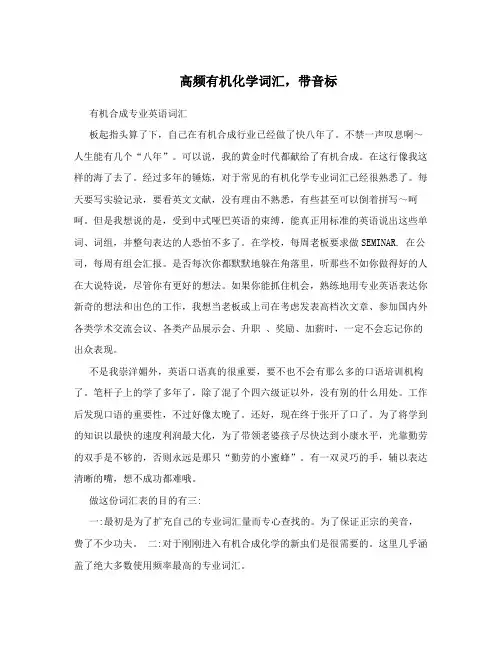
高频有机化学词汇,带音标有机合成专业英语词汇板起指头算了下,自己在有机合成行业已经做了快八年了。
不禁一声叹息啊~人生能有几个“八年”。
可以说,我的黄金时代都献给了有机合成。
在这行像我这样的海了去了。
经过多年的锤炼,对于常见的有机化学专业词汇已经很熟悉了。
每天要写实验记录,要看英文文献,没有理由不熟悉,有些甚至可以倒着拼写~呵呵。
但是我想说的是,受到中式哑巴英语的束缚,能真正用标准的英语说出这些单词、词组,并整句表达的人恐怕不多了。
在学校,每周老板要求做SEMINAR. 在公司,每周有组会汇报。
是否每次你都默默地躲在角落里,听那些不如你做得好的人在大说特说,尽管你有更好的想法。
如果你能抓住机会,熟练地用专业英语表达你新奇的想法和出色的工作,我想当老板或上司在考虑发表高档次文章、参加国内外各类学术交流会议、各类产品展示会、升职、奖励、加薪时,一定不会忘记你的出众表现。
不是我崇洋媚外,英语口语真的很重要,要不也不会有那么多的口语培训机构了。
笔杆子上的学了多年了,除了混了个四六级证以外,没有别的什么用处。
工作后发现口语的重要性,不过好像太晚了。
还好,现在终于张开了口了。
为了将学到的知识以最快的速度利润最大化,为了带领老婆孩子尽快达到小康水平,光靠勤劳的双手是不够的,否则永远是那只“勤劳的小蜜蜂”。
有一双灵巧的手,辅以表达清晰的嘴,想不成功都难哦。
做这份词汇表的目的有三:一:最初是为了扩充自己的专业词汇量而专心查找的。
为了保证正宗的美音,费了不少功夫。
二:对于刚刚进入有机合成化学的新虫们是很需要的。
这里几乎涵盖了绝大多数使用频率最高的专业词汇。
三:对于有多年有机合成经验而有海量专业词汇的虫精们,希望能帮助你走出无声的合成工作,全面提高您的综合素质。
再次提醒,由于知识水平所限,这里只列出了最基本的词汇,可以说是基础有机化学专业词汇。
大家可以根据自己的情况进行补充和删减,以便得到一份更适合自己的词汇表。
不过万变不离其宗,学习英语词汇的关键是掌握词根。
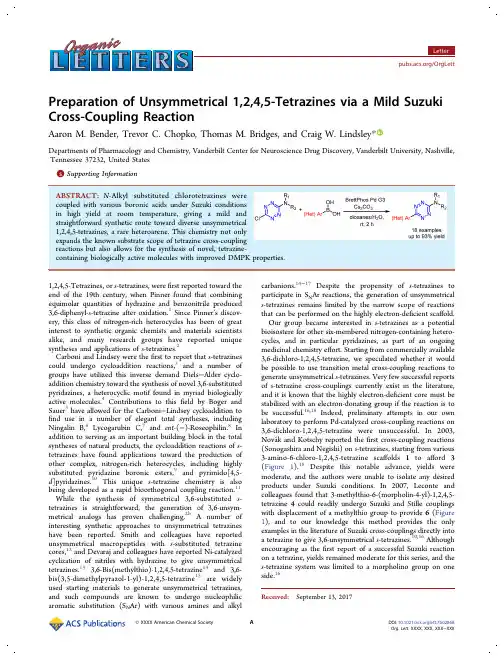
Preparation of Unsymmetrical1,2,4,5-Tetrazines via a Mild Suzuki Cross-Coupling ReactionAaron M.Bender,Trevor C.Chopko,Thomas M.Bridges,and Craig W.Lindsley*Departments of Pharmacology and Chemistry,Vanderbilt Center for Neuroscience Drug Discovery,Vanderbilt University,Nashville, Tennessee37232,United States*Supporting Informationproperties.1,2,4,5-Tetrazines,or s-tetrazines,werefirst reported toward the end of the19th century,when Pinner found that combining equimolar quantities of hydrazine and benzonitrile produced 3,6-diphenyl-s-tetrazine after oxidation.1Since Pinner’s discov-ery,this class of nitrogen-rich heterocycles has been of great interest to synthetic organic chemists and materials scientists alike,and many research groups have reported unique syntheses and applications of s-tetrazines.2Carboni and Lindsey were thefirst to report that s-tetrazines could undergo cycloaddition reactions,3and a number of groups have utilized this inverse demand Diels−Alder cyclo-addition chemistry toward the synthesis of novel3,6-substituted pyridazines,a heterocyclic motif found in myriad biologically active molecules.4Contributions to thisfield by Boger and Sauer5have allowed for the Carboni−Lindsey cycloaddition to find use in a number of elegant total syntheses,including Ningalin B,6Lycogarubin C,7and ent-(−)-Roseophilin.8In addition to serving as an important building block in the total syntheses of natural products,the cycloaddition reactions of s-tetrazines have found applications toward the production of other complex,nitrogen-rich heterocycles,including highly substituted pyridazine boronic esters,9and pyrimido[4,5-d]pyridazines.10This unique s-tetrazine chemistry is also being developed as a rapid bioorthogonal coupling reaction.11 While the synthesis of symmetrical3,6-substituted s-tetrazines is straightforward,the generation of3,6-unsym-metrical analogs has proven challenging.2b A number of interesting synthetic approaches to unsymmetrical tetrazines have been reported.Smith and colleagues have reported unsymmetrical macropeptides with s-substituted tetrazine cores,12and Devaraj and colleagues have reported Ni-catalyzed cyclization of nitriles with hydrazine to give unsymmetrical tetrazines.133,6-Bis(methylthio)-1,2,4,5-tetrazine14and3,6-bis(3,5-dimethylpyrazol-1-yl)-1,2,4,5-tetrazine15are widely used starting materials to generate unsymmetrical tetrazines, and such compounds are known to undergo nucleophilic aromatic substitution(S N Ar)with various amines and alkyl carbanions.14−17Despite the propensity of s-tetrazines to participate in S N Ar reactions,the generation of unsymmetrical s-tetrazines remains limited by the narrow scope of reactions that can be performed on the highly electron-deficient scaffold. Our group became interested in s-tetrazines as a potential bioisostere for other six-membered nitrogen-containing hetero-cycles,and in particular pyridazines,as part of an ongoing medicinal chemistry effort.Starting from commercially available 3,6-dichloro-1,2,4,5-tetrazine,we speculated whether it would be possible to use transition metal cross-coupling reactions to generate unsymmetrical s-tetrazines.Very few successful reports of s-tetrazine cross-couplings currently exist in the literature, and it is known that the highly electron-deficient core must be stabilized with an electron-donating group if the reaction is to be successful.16,18Indeed,preliminary attempts in our own laboratory to perform Pd-catalyzed cross-coupling reactions on 3,6-dichloro-1,2,4,5-tetrazine were unsuccessful.In2003, Nova k and Kotschy reported thefirst cross-coupling reactions (Sonogashira and Negishi)on s-tetrazines,starting from various 3-amino-6-chloro-1,2,4,5-tetrazine scaffolds1to afford3 (Figure1).18Despite this notable advance,yields were moderate,and the authors were unable to isolate any desired products under Suzuki conditions.In2007,Leconte and colleagues found that3-methylthio-6-(morpholin-4-yl)-1,2,4,5-tetrazine4could readily undergo Suzuki and Stille couplings with displacement of a methylthio group to provide6(Figure 1),and to our knowledge this method provides the only examples in the literature of Suzuki cross-couplings directly into a tetrazine to give3,6-unsymmetrical s-tetrazines.10,16Although encouraging as thefirst report of a successful Suzuki reaction on a tetrazine,yields remained moderate for this series,and the s-tetrazine system was limited to a morpholino group on one side.16Received:September13,2017We therefore wondered if the scope of this reaction could be expanded to include other amino-substituted s -tetrazines,speci fically amines not limited to a closed,tertiary ring system (i.e.,morpholino).Additionally,we were interested in the optimization of milder reaction conditions,as yields in the previous report for Suzuki couplings were increased only through microwave synthesis at 200°C.16For our optimization study,we therefore selected N -butyl-6-chloro-1,2,4,5-tetrazin-3-amine (7),synthesized under previously reported conditions from 3,6-dichloro-1,2,4,5-tetrazine (Table 1).19A screen of palladium catalysts (10%loading with phenylboronic acid and K 2CO 3as base)encouragingly indicated several promising systems,including Pd(dppf)Cl 2(entry 5)and the third generation BrettPhos palladacycle (entry 6),20both of which gave moderate yields of desired product 8after 1h at 100°C.Increasing the reaction time to 2h with both catalysts improved yield due to the complete consumption of starting material (entries 9and 10),particularly in the case of the BrettPhos palladacycle.Changing the base to Cs 2CO 3further improved yield using this catalyst (entry 11,92%yield),and we were encouraged to find that this reaction could be run with comparable yields both at 70°C and even at room temperature (entries 16and 18)and at a reduced catalyst loading of 5%at room temperature (entry 19,90%yield).A 1%catalyst loading at room temperature (entry 20)resulted in signi ficantly decreased yield compared to entry 19,although a 1%catalyst loading at 70°C proved successful (entry 21,81%yield).These mild reaction conditions and high yields are a testament to the robustness of this and other Buchwald palladacycles,partic-ularly for otherwise problematic or unreactive coupling partners,and the mild conditions reported for entry 19were selected for further substrate scope studies.Utilizing these optimized reaction conditions,8was isolated in 93%yield after column chromatography.With conditions optimized for 7and phenylboronic acid,we next sought to expand the scope of the boronic acid coupling partner (Scheme 1).Under the optimized conditions,2-,3-,and 4-methoxyphenylboronic acid all proved high yielding as a coupling partner (9a −c ),as did 4-methylphenylboronic acid (9d ).In cases of electron-de ficient aromatic rings such as 4-tri fluoromethyl (9e )and 4-nitrile (9f ),yields proved lower at room temperature (48%for 9e and 18%for 9f ),although the total recovery of 9f could be dramatically increased by running the reaction at 70°C under otherwise identical conditions (86%).Heteroaryl bicyclic ring systems (9g and 9h )were also tolerated,albeit in diminished yield for 6-quinoline 9g .The coupling of 7with potassium vinyltri fluoroborate (product 9i )proved sluggish at room temperature,although this product could also be isolated in high yield by increasing the temperature to 70°C (73%).This result was particularly encouraging,as vinyl-substituted s -tetrazines are of interest as a class of precursors to highly nitrogen-rich polymers,and to our knowledge there are no known previous examples of a successful cross-coupling between an s -tetrazine and a vinyl group.21This methodology should therefore prove straightfor-ward for the generation of new vinyltetrazines.Furthermore,protic substrates such as 4-hydroxyphenylboronic acid (9j ),smaller aromatic systems (methylpyrazole 9k )as well as 4-Boc-aminophenylboronic acid (9l )also proved compatible under our conditions with substrate 7,and all were isolatedinFigure 1.Previously reported Pd-catalyzed cross-coupling reactions of s -tetrazines.16,18Table 1.Optimization of the Suzuki Coupling Conditionsaentry catalyst catalyst loading base temp (°C)time (h)yield (%)b1RuPhos Pd G310K 2CO 31001502Pd(OAc)210K 2CO 31001123Pd(PPh 3)410K 2CO 31001534Pd 2(dba)310K 2CO 3100165Pd(dppf)Cl 2·DCM 10K 2CO 31001636BrettPhos Pd G310K 2CO 31001607tBuXPhos Pd G310K 2CO 3100138Pd(amphos)Cl 210K 2CO 31001599Pd(dppf)Cl 2·DCM 10K 2CO 310027110BrettPhos Pd G310K 2CO 310028511BrettPhos Pd G310Cs 2CO 310029212BrettPhos Pd G310K 3PO 410028913BrettPhos Pd G310DIPEA 10026514BrettPhos Pd G310CH 3COONa 10023115BrettPhos Pd G310Cs 2CO 313016316BrettPhos Pd G310Cs 2CO 37029717BrettPhos Pd G310Cs 2CO 35029418BrettPhosPd G310Cs 2CO 3rt 29019BrettPhos Pd G35Cs 2CO 3rt 29020BrettPhosPd G31Cs 2CO 3rt 2721BrettPhosPd G31Cs 2CO 370281a Reaction conditions:7(30mg,0.16mmol),PhB(OH)2(1.2equiv),base(3.0equiv),5:11,4-dioxanes/H 2O (1.0mL).b Yields determinedby LCMS using anisole as internal standard.moderate to high yield.Thus,the optimized conditions a fforded broad scope and general applicability to aryl,heteroaryl,and vinyl boronic acid coupling partners to deliver analogs 9.We next turned our attention to the replacement of the N -butyl substitution (10)(Scheme 2)and synthesized N -benzyl-6-chloro-1,2,4,5-tetrazin-3-amine (10a ),3-chloro-6-(1-piperid-yl)-1,2,4,5-tetrazine (10b ),6-chloro-N -phenyl-1,2,4,5-tetrazin-3-amine (10c ),4-(6-chloro-1,2,4,5-tetrazin-3-yl)morpholine (10d ),and 3-butoxy-6-chloro-1,2,4,5-tetrazine (10e )in con-ditions similar to those for the synthesis of 7(see Supporting Information ).These substrates were selected in order to probe the electronic requirements of the group donating electron density to the chloro -s -tetrazine core.Our conditions proved successful for benzylamine 11a ,piperidine 11b ,aniline 11c ,and morpholine 11d ,although no evidence of desired product could be detected by LCMS in the case of butoxy-s -tetrazine 11e (Scheme 2).These results indicate that our Suzuki conditions can tolerate a variety of di fferent amino-s -tetrazines while maintaining good yields,and optimization e fforts toward conditions for ether-containing tetrazine substrates are ongoing in our laboratory.There are few reported examples of tetrazine motifs in biologically active molecules,22and structure −activity relation-ship (SAR)studies that include this unusual heterocycle have historically been limited largely due to an inability to rapidly and consistently generate unsymmetrical substituted s -tetra-zines.We therefore became interested in utilizing our optimized Suzuki conditions to generate a direct s -tetrazine analog of an existing molecule (12)and were aware of a report describing 3,6-substituted pyridazines as acetylcholinesterase (AChE)inhibitors,structurally related to minaprine (Scheme 3).23Using a simple,two-step S N Ar/Suzuki-coupling sequence starting from amine 13(Scheme 3),we were able to generate a direct s -tetrazine analog (15)of the existing molecule (12)in high yield under mild conditions and to compare the human hepatic microsomal intrinsic clearance (CL int )and plasma protein binding (PPB)as the fraction unbound (fu )of each (Table 2),conducted as previously described.24The tetrazineanalog 15displayed greater than 3-fold improvement (i.e.,Scheme 1.Scope of the Suzuki Coupling with 7a a Standard reaction conditions:7(30mg,0.16mmol),RB(OH)2(1.2equiv),base (3.0equiv),5:11,4-dioxanes/H 2O (1.0mL).Isolated yields after column chromatography.b Reaction run at 70°C.Scheme 2.Scope of the Suzuki Coupling with 10a aStandard reaction conditions:10(30mg,0.16mmol),RB(OH)2(1.2equiv),base (3.0equiv),5:11,4-dioxanes/H 2O (1.0mL).Isolatedyields after column chromatography.Scheme 3.Synthesis of AChE Inhibitor Analog15Table parison of Human CLint ,Predicted CL hep ,PPB,andcLogP for Analogs 12and 15compd CL INT (hum)mL/min/kg CL HEP (hum)mL/min/kg f u (plasma)(%)cLogP a 124614 2.5 5.515148.3 2.6 4.4a Calculated using ChemDraw Professional version 16.0.reduction)in human hepatic intrinsic clearance compared to the pyridazine analog12,while both showed comparable f u values in the PPB pound15was also found to maintain activity as an AChE inhibitor(Scheme3).25 Incorporation of the s-tetrazine moiety can therefore maintain certain desirable drug metabolism and pharmacokinetic (DMPK)properties in existing molecules,and in this case even reduced the rate of metabolic clearance(in vitro). Additionally,replacement of the pyridazine with the tetrazine moves the molecule into an improved drug-like space in terms of cLogP(5.5vs4.4).In conclusion,the facile cross-coupling chemistry described herein should allow for the generation of new,drug-like, tetrazine-containing molecules and enable further SAR and DMPK studies around such scaffolds,as well as open avenues for the further incorporation and study of tetrazine cores as replacements for pyridazines,pyrimidines,and pyrazines inpharmaceuticals,agrochemicals,and for the material sciences.■ASSOCIATED CONTENT*Supporting InformationThe Supporting Information is available free of charge on the ACS Publications website at DOI:10.1021/acs.or-glett.7b02868.Experimental procedures,characterization data,and1H and13C NMR spectra for new compounds(PDF)■AUTHOR INFORMATIONCorresponding Author*E-mail:craig.lindsley@.ORCIDCraig W.Lindsley:0000-0003-0168-1445NotesThe authors declare no competingfinancial interest.■ACKNOWLEDGMENTSC.W.L.thanks the William K.Warren Family and Foundation for funding the William K.Warren,Jr.Chair in Medicine andsupport of our programs.■REFERENCES(1)Pinner,A.Ber.Dtsch.Chem.Ges.1893,26,2126.(2)For selected reviews:(a)Churakov,A.M.;Tartakovsky,V.A. Chem.Rev.2004,104,2601.(b)Saracoglu,N.Tetrahedron2007,63, 4199.(c)Clavier,G.;Audebert,P.Chem.Rev.2010,110,3299.(3)Carboni,R.A.;Lindsey,R.V.J.Am.Chem.Soc.1959,81,4342.(4)(a)Wermuth,C.G.MedChemComm2011,2,935.(b)Bender,A. M.;Weiner,R.L.;Luscombe,V.B.;Ajmera,S.;Cho,H.P.;Chang,S.; Zhan,X.;Rodriguez,A.L.;Niswender,C.M.;Engers,D.W.;Bridges, T.M.;Conn,P.J.;Lindsley,C.W.Bioorg.Med.Chem.Lett.2017,27, 3576.(5)(a)Boger,D.L.Chem.Rev.1986,86,781.(b)Sauer,J.;Pabst,G. R.;Holland,U.;Kim,H.-S.;Loebbecke,.Chem.2001, 2001,697.(6)Boger,D.L.;Soenen,D.R.;Boyce,C.W.;Hedrick,M.P.;Jin,Q. .Chem.2000,65,2479.(7)Oakdale,J.S.;Boger,.Lett.2010,12,1132−1134.(8)Boger,D.L.;Hong,J.J.Am.Chem.Soc.2001,123,8515.(9)Helm,M.D.;Moore,J.M.;Plant,A.;Harrity,J.P.A.Angew. Chem.,Int.Ed.2005,44,3889.(10)Galeta,J.;Sala,M.;Dracinsky,M.;Vrabel,M.;Havlas,Z.; Nencka,.Lett.2016,18,3594.(11)(a)Devaraj,N.K.;Weissleder,R.Acc.Chem.Res.2011,44,816.(b)Ramil,C.P.;Dong,M.;An,P.;Lewandowski,T.M.;Yu,Z.; Miller,L.J.;Lin,Q.J.Am.Chem.Soc.2017,139,13376.(12)(a)Brown,S.P.;Smith,A.B.J.Am.Chem.Soc.2015,137,4034.(b)Abdo,M.;Brown,S.P.;Courter,J.R.;Tucker,M.J.;Hochstrasser, R.M.;Smith,.Lett.2012,14,3518.(13)Yang,J.;Karver,M.R.;Li,W.;Sahu,S.;Devaraj,N.K.Angew. Chem.,Int.Ed.2012,51,5222.(14)Boger,D.L.;Sakya,.Chem.1988,53,1415.(15)Rusinov,G.L.;Latosh,N.I.;Ganebnykh,I.I.;Ishmetova,R.I.; Ignatenko,N.K.;Chupakhin,.Chem.2006,42,757.(16)Leconte,N.;Keromnes-Wuillaume,A.;Suzenet,F.;Guillaumet,G.Synlett2007,2007,0204.(17)Zhou,Q.;Audebert,P.;Clavier,G.;Miomandre,F.;Tang,J. RSC Adv.2014,4,7193.(18)Novak,Z.;Kotschy,.Lett.2003,5,3495.(19)(a)Bender,J.A.;Gentles,R.G.;Pendri,A.;Wang,A.X.; Meanwell,N.A.;Beno,B.R.;Fridell,R.A.;Makonen,B.;Nguyen,V. N.;Yang,Z.;Wang,G.;Kumaravel,S.;Thangathirupathy,S.;Bora,R. O.;Holehatti,S.M.;Mettu,M.R.;Panda,M.International Publication Number2016/WO172424A1,2016.(b)Novak,Z.;Bostai,B.; Csekei,M.;Lorincz,K.;Kotschy,A.Heterocycles2003,60,2653. (20)(a)Bruno,N.C.;Tudge,M.T.;Buchwald,S.L.Chem.Sci. 2013,4,916.(b)Bruno,N.C.;Niljianskul,N.;Buchwald,. Chem.2014,79,4161.(21)Pican,S.;Lapinte,V.;Pilard,J.;Pasquinet, E.;Beller,L.; Fontaine,L.;Poullain,D.Synlett2009,2009,731.(22)(a)Werbel,L.M.;McNamara,D.J.;Colbry,N.L.;Johnson,J. L.;Degnan,M.J.;Whitney,B.J.Heterocycl.Chem.1979,16,881.(b)Xu,F.;Yang,Z.;Ke,Z.;Xi,L.;Yan,Q.;Yang,W.;Zhu,L.;Lv,W.; Wu,H.;Wang,J.;Li,H.Bioorg.Med.Chem.Lett.2016,26,4580. (23)Contreras,J.;Rival,Y.M.;Chayer,S.;Bourguignon,J.; Wermuth,C.G.J.Med.Chem.1999,42,730.(24)(a)Wenthur,C.J.;Morrison,R.;Felts,A.S.;Smith,K.A.; Engers,J.L.;Byers,F.W.;Daniels,J.S.;Emmitte,K.A.;Conn,P.J.; Lindsley,C.W.J.Med.Chem.2013,56,5208.(b)Engers,D.W.; Blobaum,A.L.;Gogliotti,R.D.;Cheung,Y.;Salovich,J.M.;Garcia-Barrantes,P.M.;Daniels,J.S.;Morrison,R.;Jones,C.K.;Soars,M.G.;Zhuo,X.;Hurley,J.;Macor,J.E.;Bronson,J.J.;Conn,P.J.; Lindsley, C.W.;Niswender, C.M.;Hopkins, C.R.ACS Chem. Neurosci.2016,7,1192.(c)Bridges,T.M.;Rook,J.M.;Noetzel,M.J.; Morrison,R.D.;Zhou,Y.;Gogliotti,R.D.;Vinson,P.N.;Xiang,Z.; Jones,C.K.;Niswender,C.M.;Lindsley,C.W.;Stauffer,S.R.;Conn, P.J.;Daniels,J.S.Drug Metab.Dispos.2013,41,1703.(25)Human AChE inhibition assay by Eurofins using the method described by Ellman(Biochem.Pharmacol.1961,7,88).。
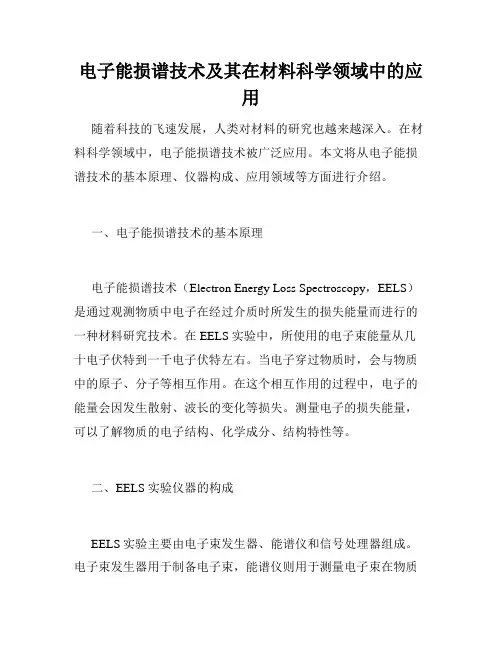
电子能损谱技术及其在材料科学领域中的应用随着科技的飞速发展,人类对材料的研究也越来越深入。
在材料科学领域中,电子能损谱技术被广泛应用。
本文将从电子能损谱技术的基本原理、仪器构成、应用领域等方面进行介绍。
一、电子能损谱技术的基本原理电子能损谱技术(Electron Energy Loss Spectroscopy,EELS)是通过观测物质中电子在经过介质时所发生的损失能量而进行的一种材料研究技术。
在EELS实验中,所使用的电子束能量从几十电子伏特到一千电子伏特左右。
当电子穿过物质时,会与物质中的原子、分子等相互作用。
在这个相互作用的过程中,电子的能量会因发生散射、波长的变化等损失。
测量电子的损失能量,可以了解物质的电子结构、化学成分、结构特性等。
二、EELS实验仪器的构成EELS实验主要由电子束发生器、能谱仪和信号处理器组成。
电子束发生器用于制备电子束,能谱仪则用于测量电子束在物质中的能量损失情况,而信号处理器则用于处理测量到的电子能损谱图(EEL谱图)。
在EELS实验中,电子束发生器一般采用透射电子显微镜(Transmission Electron Microscope,TEM)或扫描透射电子显微镜(Scanning Transmission Electron Microscopy,STEM)。
TEM 和STEM可以提供很高的空间分辨率,从而使得对材料进行微观结构分析时,可以看到更多的细节和特征。
能谱仪则是EELS实验的核心设备。
能谱仪在TEM或STEM 中设置,其主要作用是测量电子束在物质中的能量损失情况。
能谱仪分为两种类型:全能谱仪和分散能谱仪。
全能谱仪可以连续地记录所有能量损失;而分散能谱仪则可以分离出不同能量损失的电子,对其进行记录和分析。
信号处理器用于对EEL谱图进行处理,提取出所需要的信息。
信号处理器可使用的软件有多种,如Python和MATLAB等。
在处理过程中,本文使用MATLAB对EEL谱图进行处理和分析。
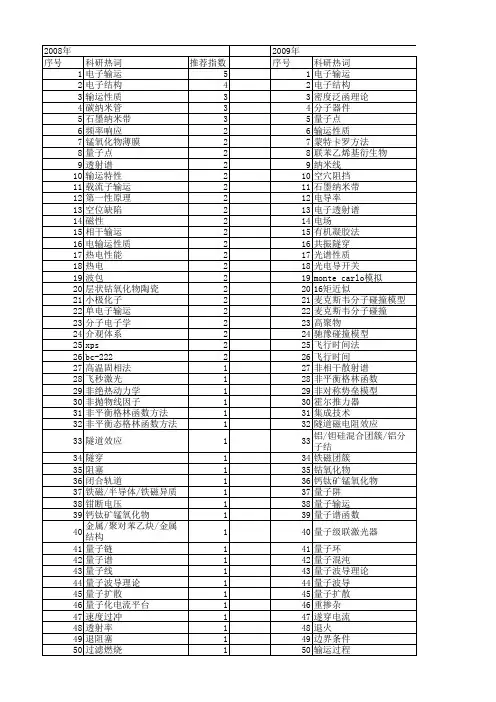
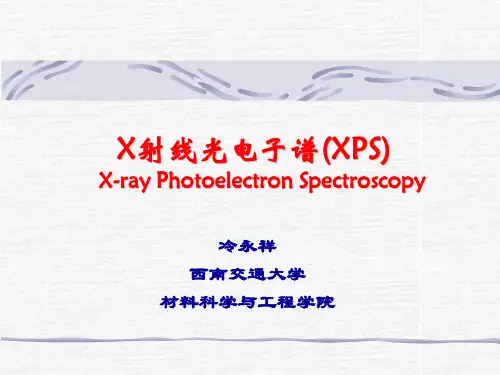
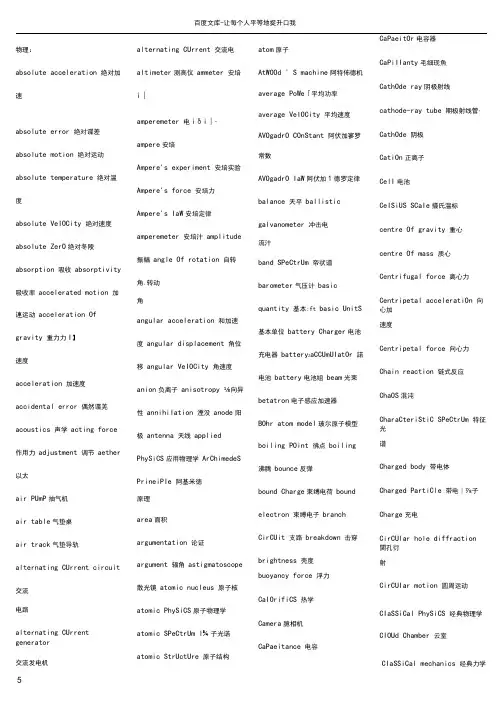
物理:absolute acceleration 绝对加速absolute error 绝对谍差absolute motion 绝对运动absolute temperature 绝对温度absolute VeIOCity 绝对速度absolute ZerO绝对冬陵absorption 吸收absorptivity 吸收率accelerated motion 加連运动acceleration Ofgravity 重力力I】速度acceleration 加速度accidental error 偶然谍羌acoustics 声学acting force 作用力adjustment 调节aether 以太air PUmP抽气机air table气垫桌air track气垫导轨alternating CUrrent circuit 交流电路alternating CUrrent generator交流发电机alternating CUrrent 交流电altimeter测高仪ammeter 安培i∣amperemeter 电iδi∣∙ampere安培Ampere's experiment 安培实验Ampere's force 安培力Ampere's IaW安培定律amperemeter 安培汁amplitude振幅angle Of rotation 自转角.转动角angular acceleration 和加速度angular displacement 角位移angular VeIOCity 角速度anion负离子anisotropy ⅛向异性annihilation 湮没anode阳极antenna 天线appliedPhySiCS应用物理学ArChimedeSPrineiPIe 阿基米徳原理area面积argumentation 论证argument 辐角astigmatoscope散光镜atomic nucleus 原子核atomic PhySiCS原子物理学atomic SPeCtrUm l¾子光诺atomic StrUctUre 原子结构atom原子AtWOOd ' S machine阿特佈德机average PoWe「平均功率average VeIOCity 平均速度AVOgadrO COnStant 阿伏加寥罗常数AVOgadrO IaW阿伏加1德罗定律balance 天平ballisticgalvanometer 冲击电流汁band SPeCtrUm 帝状谱barometer气压计basicquantity 基本:ft basic UnitS基本单位battery Charger电池充电器battery Z aCCUmUIatOr 諾电池battery电池组beam光束betatron电子感应加速器BOhr atom model玻尔原子模型boiling POint 彿点boiling沸腾bounce反弹bound Charge束缚电荷boundelectron 束缚电子branchCirCUit 支路breakdown 击穿brightness 壳度buoyancy force 浮力CaIOrifiCS 热学Camera臆相机CaPaeitance 电容CaPaeitOr电容器CaPiIIanty毛细现魚CathOde ray阴极射线cathode-ray tube 期极射线管∙CathOde 阴极CatiOn正离子CelI电池CeISiUS SCaIe摄氏温标centre Of gravity 重心centre Of mass 质心Centrifugal force 离心力Centripetal acceleratiOn 向心加速度Centripetal force 向心力Chain reaction 链式反应ChaOS混沌CharaCteriStiC SPeCtrUm 特征光谱Charged body 带电体Charged PartiCle 带电∣⅞子Charge充电CirCUlar hole diffraction関孔衍射CirCUIar motion 圆周运动CIaSSiCal PhySiCS 经典物理学CIOUd Chamber 云室CIaSSiCal mechanics 经典力学5COeffiCient Of maximum StatiC friction嚴人静般瞼系数∞efficient Of restitution 恢复系数∞efficient Of Sliding friction 滑动味擦系数COeffiCient 系数COherent Iight 柿干光JS∞il线圈∞llision 碰撞COmPOnent force 分力COmPOnent VeIOCity 分速度COmPOSitiOn OffO「ces 力的合成∞mposition Of VelOCitieS 速度的合成∞mpression 压缩COnCaVe IenS IUI透敏COnCaVe mirror PU[fi)t⅛ConCUrrent force 共点力∞ndensatiOn 凝结∞ndenser电容器COndUCting medium 导电介质∞nductor 导体COnSerVatiVe force field 保守力场8∏SerVatiVe force 保守力∞nstant force 恒力COnStant 7⅛fi⅛COntinUOUS SPectrUm 连续谱COnVergent IenS 会聚透镀COnVeX IenS 凸透做COnVeX mirror 凸血做COOrdinate SyStem 坐标系COPIanar force 共面力COrOliS force科里奥利力COrPUSCUIar PrOPerty 粒子性COrPUSCUIar theory 微粒说COUlOmb force 库仑力COUIOmb 库仑COUIOmb's IaW库仑宦律COUnter汁数器CreatiOn 产生CreePage iW⅛CreSt波娜CritiCal angle 临界角CntiCal resistance 临界电阻CritiCal temperature 临界ifi度CrYStal 品体CUrrent density 电流密度CUrrent element 电滾元CUrrent SOUrCe 电流滅CUrrent Strength 电流儀度CUrVilinear motion 曲纟戈运动CyClOtrOn回皈加速器dampedVibratiOn 阻尼抿动damping 阻尼DanieII CeIl丹聂耳电池data PrOCeSSing 数据处理data数据decay哀变definitiOn Ofampere 安培的定义defocusing Ift集density 密度derived quantity 导出βtderived Unit导出单位dielectric 电介质diffraction Pattern 衍射图样diffraction 衍射diffuse reflection 没反射digital timer数字计时器dimensional expOnent 址纲播数dimension Ift纲diode二级骨diopter屈光度direct CUrrentrDC 宜流direct impact 正碰direct measurement H接测试discharge 放电disorder 无序dispersion 色散displacement位移divergent IenS 发散透後DOPPler effect多普勒效应double SIit diffraction 双縫衍射driving force 驰动力dryCell干电池echo回声eddyCUrrent 涡流effective VaIUe冇效值elastic body 弹性体elastic force 弹[性]力elasticity 弹性electricCharge 电荷electric CirCUit电路electric COrOna 电∙⅛electric energy 电能electric field 电场electricfield intensity 电场强度electric field Iine 电场线electric flux 电通⅛electric Ieakage iW⅛electric neutrality 电中性electric POtential 电位・电势electric POtentialdifference 电位差∙电势菱electric POtential energy电位能electric POWer 电功率electric quantity ⅛ftelectrification 起电electrification by friction摩擦起电electrified body 帯电体electrode 电极electrolysis5电解electrolyte 电解质electromagnetic damping 电阻尼electromagnetic inductiOn 电磁感应electromagnetic radiation 电够辐鮎electromagnetic WaVe 电磁波electromagnetic WaVe SPeCtrUm电磁波谱electromagnetism induction PhenOmenOn电磁感应现皱electromagnet 电4⅛体electrometer 静电计electromotive force 电动势electron 电子electron beam 电子束electron CIOUd 电子云electron microscope 电子显微镜electron VOIt电子伏特electroscope 脸电器electrostatic equilibrium tff t电平衡electrostatic induction 静电感应electrostatic SCreening 静电屛蔽elementary Charge 基本电荷•元电荷energy能蛾energy IeVel 能级equilibrium 平衡equilibrium COnditiOn 平衡条件equilibrium Of forces 力的平衡equilibrium POSitiOni I z t⅛{⅛Hequilibrium State 平衡态equivalent SOUrCe theorem等效电源定理erect image IE像error i¾差ether以太evaporation 蒸发excitation 激发excitation State 激发态e×periment 实脸experimental PhySiCS 实舫物理学external force 外力eyepiece 11镜far Sight 远视Faraday CyIinder法拉第阴筒Faraday IaW Ofelectromagnetic induction法拉笫电鐵感应定律Faraday1S IaW Ofelectromag netic in duct 法拉笫电磁感应定律farad法拉(电容的单位)filminterference 薄膜干涉finalVeIOCity 来速度first COSmiCVeIOdty 第一宇宙速度fission 裂变fixed-axis rotation 定轴转动flotation balance 浮力秤fluid流体focal Iength 焦距focusing调焦•聚焦focus焦点force 力forced VibratiOn 受迫报动fractal 分形free Charge白由电荷free electron自由电子free PeriOd自由周期freezingPOint ⅛f固点frequency 频率friction force 攣擦力fusion聚变galva no meterItIjiliir gas气体general PhySiCS普通物理学generator发电机goodCOndUCtOr 良导体gravitation引力gravity 重力gravitational POtentialenergy重力势能gravity field 鱼力场groundearth 接上也ground State 基态ground Wire 地线hadron强子half Iife PeriOd 半衰期heat 热heat transfer 传热henry亨利hertz赫兹(频率的单位)HOOke IaW胡克定律humidity 湿度hydrogen包原子hypothesis J l-1& ice POint冰点ideal gas理想气体image像image distance 像距imageheight 像岛imaging 成像imperfect inelasticCOlIiSiOn 非完全弹性碰撞impulse 冲fltincident angle 入射角incident ray 入肘线indirect measurement 何接测fitinduced electric CUrrent 感应电流induced electric field 感应5流inductiOn electromotive force感应电动势induction motor感应电动机inertia 惯性inertial force 惯性力inertial SyStem 惯性系infrared ray 红外线infrasOniC WaVe 次声波initial PhaSe 初位相initial VeIOCity 初速度input输入instantaneous POWer 瞬时功率instantaneous VeIOCity 瞬时速度instrument 仪器insulated COndUCtOr 绝缘导体insulating medium 绝缘介质insulator绝缘体intensity Of SOUnd 沖强interference 干涉interference fringe 干涉条纹interference Pattern「•涉图样interferometer 干涉仪internal energy 内能internal force 内力internal resistance 内阻intonation 声调inVerted image 倒像beam离子束ionization 电离irreversible ProCeSS 不川逆过程isobaric PrOCeSS 等用过程isobar等压线isochoricPrOCeSS等体枳过程isothermal等温线isothermal PrOCeSS 等温过程isotope同位索isotropy各向同性joule條耳(功的单位)JOUIe heat 焦EF热JOUle IaW焦耳定律Joule, IaW焦耳定律KePIer IaW开普勒定律kinematics 运动学kineticenergy 动能Laplace's equation 拉普拉斯方程IaSe「激光•激光器IaW定律IaW Of COnSerVatiOn Ofangular momentum角动:#守恒定律IaW Of ConSerVatiOn Ofenergy 能定律IaW Of COnSerVatiOn Of mass质址守也定律IaW Of COnSerVati On Ofmechanical energy 机械能9也定律IaW Of COnSerVatiOn Ofmomentum 动扯守也定律Le SySteme Intemational d 'Unit e S IH际单位制(Sl)Iead导线Iength长度IenS透镜IenS formula透越公式Lenz,s IaW楞次定律IePtOn轻子IJght ray 光线Iight SOUrCe 光源Iight WaVe 光波Iightning rod 避苗针Iight 光Iine SPeCtrUm 线状谱IineS Of CUrrent 电渍线IineS Of force Of electricfield 电力线IiqUefaCtiOn 液化IiqUefaCtiOn POint 液化点IiqUid液体IOngitUdinal WaVe 纵波IOOP回路LOrentZ force洛仑兹力IUminOUS intensity 发光强度magnetic field 磁场magneticfield intensity 出场强magnetic field Iine ft⅛场线magnetic induction flux 磁感应magnetic induction 險感应⅞8度magn etic in duction IineIK 感应线magnetic material 險性材料magnetic needle ⅛⅛flmagnetic POIe 磁极magnetics⅛S学magnetism 4⅛学magnetization 磁化magnet i⅛体magnifkatiOn 放人率magnifier放A;镀.放人器manometer流体压强i∣∙ mass质嫩mass defect 质Ift亏损mass-ene「gy equation 质能方程matter物质matter WaVe 物质波MaXWeIrS equations 麦克斯韦方程组mean SPeed平均速率mean VelOCity平均速度measurement 测fitmechanical energy 机械能5mechanical motion 机械运动mechanical VibratiOn 机械振动mechanics 力学medium介质melting fusion 熔化melting POint 熔点metre rule 米尺microdetector灵敬电流计micrometer CaliPeri⅛δ⅛⅛)J微器microscope V3Si⅛ microscopic PartiCIe 微观粒子mirror reflectiOn 镜面反射mirror t⅛ mixed Unit SyStem混合单位制modern PhySiCS现代物理学molar VOlUme摩尔体积molecular SPeCtrUm 分子光谱molecular StrUctUre 分子结构moment Of force 力矩momentum Of electromagnetic field电磁场的动St momentum 动知:motor电动机multimeter多用[电]表musical quality 音色N POIe北极natural frequency 固冇须率natural Iight 自然光negative Charge 负电荷negative CryStal 负品体negative ion 负离F negativePIate 负极板network 网络neutralization 中和neutron中子newton牛顿(力的单位)NeWtOn first Iaw牛顿第一宦律NeWtOn SeCOnd IaW 牛顿第•定律NeWtOn third IaW牛顿笫〔定律nonequilibrium State IF F衡态north POIe 北极nucleus force 核力nucleus Of COndenSatiOn ⅛(结核ObjeCt 物ObjeCt distance 物距ObjeCt height 物高ObjeCtiVe 物越ObSerVatiOn 观察Oersted's experiment 奥斯特实脸Ohm欧婀Ohrn IaW欧姆定律Ohmmeter t⅛⅛i∣Ohrn,s IaW欧姆定律OPen CirCUit 开路OPtiCal bench 光貝座OPtiCal Centre Of IenS 透境光心OPtiCal fiber光导纤维OPtiCal glass光学玻璃OPtiCal instrument 光学仪器OPtiCal IeVer 光杠杆OPtiCal Path difference 光程差OPtiCal Path 光程(路)OPtiCaIly denser medium 光密介质OPtiCalIy thinner medium 光疏介质OPtiCS光学Orbit轨道Order有序OSeiIIOgraPh 示波器OUtPUt输岀OVerWeight 超⅛.ParaIlel COnneCtiOn OfCOndenSerS电客器的井联ParaIIelOgram rule 平行四边形定律parallel-resOnance CirCUit井联谐振电路ParameterPartiCle质点•粒子PaSCal IaW帕斯卡定律Path路程Peak峰值Pendulum 摆PenUmbra 半彫PerfeCt COndUctOr 理想导体Perfect elastic COIIiSiOn完全禅性碰撞Perfect inelastic COIliSiOn完全非弹性碰撇PeriOdiCity 周期性PeriOd周期PeriSCOPe潜望镜Permanent magnet 永磁体PermittiVity Of VaCUUm 真空介电常数PermittiVity 电容率PhaSe 位扌IlPhenomenon 现線PhOtOCUrTent 光电流PhOtOeleCtriC CeIl 光电管PhOtOeIeCtriC effect 光电效应PhOtOeleCtrOn 光电子PhOtOgraPhy 照相术PhOtOn光子PhySiCal balance 物理天平PhySiCal quantity 物理fitPhySiCS物理学PieZOmeter 压强计PitCh音调5PIanCk COnStant普朗克常•肚PlaSma等离子体POint Charge 点电荷POIariZatiOn ft⅛振POIariZed Iight 偏振光POIyCryStal 多品体POOr Conductor 不艮导体POSitiVe Charge 正电荷POSitiVe CryStal 正品体POSitiVe ion 正离子POSitiVe PIate 正极板POSitrOn正电子POtential energy 势能POtentiOmeter 电位菱计POWer功率PreSSUre压强.压力Primary ∞il 原线圈PrinCiPIe Of COnStancy Of IightVelOCity光速不变原理PriSm棱镜PrOjeCtile 抛体PrOjectiIe motion 抛休运动PrOjeCtOr投影仪PrOtOn质子PUIIey滑轮PUlIey block 滑轮组quantity Of heat 热址quantization 址子化quantum 址子quantummechanics fi¾ f 力学quantum number 秋子数radar笛达radioactive SOUrCe 放射谏radius Of gyration 回旋半径random motion无规则运动「ange !⅛程rated VOltage额定电斥reacting force 反作用力real image 实像realObjeCt 实物reasOning 推理recoil反冲rectilinearmotion 宜线运动referenceframe參考系.坐标系referenceSyStem 参考系reflectedangle 反射和reflected ray 反射线reflection COeffiCient反射系数reflection IaW 反射定律reflectivity 反射率refracted angle 折射角refracted ray 折射线refraction IaW 折射定律refraction COeffiCient 折射系数refractive index 折射率relative acceleration 和对加速度relative error 对误差relative motion 相对运动relative VelOCity 相对速度relativity 相对论resistance电阻resistance box 电阻箱resistivity 电阻率resistor电阻[器]resolution Offorce 力的分解resolution OfVelOCity 速度的分解resonance共振•共呜resonantfrequency 共振频率resultantforce 合力resultantVeIOCity 合速度reversibility Of OPtiCalPath 光路町逆性reversible PrOCeSS 町逆过程rheostat变阻器right-hand SCreW FUIe 右手螺旋定则rocker火筋rotating magnetic field 旋转礙场rotation自转•转动RUtherfOrd SCattering 卢瑟福敬射RUtherfOrd [α-particleSCattering」experiment 卢瑟福LattWJ实脸S POIe南极SatUratiOn 饱和SCalar标量SCalar field 标1½场SCanner打描器SeCOnd COSmiC VeIOCity 第二宇宙速度SeIeCtiVe absorption 选择吸收self-induced electromotiveforce门感电动势self-inductance 自感self-induction PhenomenonI r l 感系数SemiCOndUCtOr 半导体Semi-transparent film 半透腹SenSitiVe galvanometer 灵坡电流计SenSitiVity 灵敏度SenSitOmeter 感光计SenSOr传感器SerieS COnn ection OfCOndenSerS电容器的串联SerieS-resOnance CirCUit 串联谐振电路ShOrt CirCUit 垃路ShOrt Sight 近视ShUnt resistor 分流电阻SignifiCant figure 仃效数了SimPIe harmOniC motion(SHM) 简谐运动SimPIe harmonic WaVe 简谐波SimPIe PendUIUm 单摆5SinglecrystakmOnOCryStaI) 单品体Single Slit diffraction 单缝衍射SinUSOidal alternating CUrrent简谐交流电SinUSOidal CUrrent 正弦式电流SIiding friction 淆动摩援Slit狭縫SOIar CeIl太阳能电池SOIenOid煤线管SOlidifiCatiOn 凝固SOlidifying POint 凝固点SOlid固体SOlUtiOn 涪液SOIVatiOn 溶解SOnar声纳SOUnd SOUrCe 筋谏SOUnd VeIOCity 声速SOUnd WaVe 声波SOUnd 声[⅛]SOUrCe电源SOUth POIe 南极SPaCe空间SPark discharge 火花放电SPedal relativity 狭义相对论SPeCifiC heat CaPadty 比热容SPeCtaCleS 眼镜SPeCtral analysis 光谱分析SPeCtral Iine [光]谱线SPeCtrOgraPh 掇谱仪SPeCtrOgraPhy 摄谱学SPeCtrOSCOPy 光谱学SPeCtrUm 光诺SPeed速率SPheriCal mirror 球面镜SPOntaneOUS radiation 门发辐射SPring balance 弹簧件Stability稳定性StabiliZed CUrrent SUPPly穗流电源StabiliZed VOItage SUPPly穂压电源Standard atmosphericPreSSUre标准人气压Standard CeIl标准电池Standing WaVe 住波StatiC friction 挣除援StatiOnary State 定态Steady CUrrent 恒定电流Steady CUrTent SOUrCe 恒流漁Steady VOItage SOUrCe 也压源Steam POint 汽点StiffneSS劲度[系数]StimUIated radiation 受激辐射StOP WatCh 停茨SUblimatiOn 升华SUPerCOndUCtiVity 超导[电]性SUPerCOnductor 超导体SUPerPOSitiOn PrineiPIe Ofelectric field电场强度叠加原理SUPerPOSitiOn theorem 盜加怎律SUPerSatUratiOn 过度饱和SUPerSOniC SPeed 趙卅速SUPerSOniC WaVe 超声波SUPPIy transformer 电源变压器SUrfaCe resistance 表面电阻SWitCh开关SyStem Of 8ncυrrent forces共点力系SyStem Of PartiCIeS 质点系SyStem Of UnitS 单位制SyStematiC error 系统误差telescope望远敏temperature 淑度tension 张力the IaW Of gravity万有引力定律theorem 原理theorem Of kinetic energy动能定理theorem Of momentum 动Ift定理theoretical PhySiCS 理论物理学theory理论thermal CaPaCity 热容[ft]thermal equilibrium 女冬平衡thermal motion 热运动thermal tranSmiSSiOn 传热thermodynamic SCaIe 〕Ofte mperatu re]热力学温标thermodynamic temperature热力学温度thermometer ⅛l¾i∣thermometric SCaIe 温标thermOnUClear reaction 热核反应thick IenS厚透镜thin IenS薄透境third COSmiC VeIOCity 第三宇宙速度three-phasealternatingCUrrent三相[交变]电流time 时IfiJtimer定时器•计时器5torsion balance Jllft-total reflection 全反射trajectory 轨道transformer 变压器transistor 品体管tramSitiOn 跃迁translation 平移transmissiOn Iine 传输线transmissivity 透射率transverse WaVe 横波triboelectrification 嘖擦起电triode三极管trough波谷tuning fork 音叉turbulent flow 祸流UItraSOUnd WaVe 趙声波UItraViOIet ray 紫外线Umbra本影UndUIatOry PrOPerty 波动性UnifOrm dielectric 均匀电介质UnifOrm motion 匀速运动Unit单位Unit SyStem 单位制UniVerSal COnStant 普适UniVerSal gravitatiOn 万有引力UniVerSal meter 多用[电]表VaCUUm tube JC空管VaCUUm 真•空VaIUe Of amplitude ⅛⅛ffi VaPOriZatiOn 汽化VariabIe 变IftVeCtOr Xft VeIOCity Of Iight 光速VeIOCity 速度VenfiCatiOn 脸证Vernie「游标Vernier CaIiPer 游标卡尺VibratiOn 掘动VieWing angle 视角VieWing field 视场VirtUal image 虚像VirtUal ObjeCt 虚物VirtUal VaIUe 有效值ViSibiIity 见度ViSibIe Iight 可见光VOltage 电压VOItage division CirCUit 分压电路VOltaiC CeIl伏打电池VOItmeter伏特汁VOItmeter-ammeter method伏安法VOlt伏特VOIUme体枳VOrteX electric field 涡族电场Watt瓦待WaVe equation波动方程WaVe theory 波动说WaVelength 波长WaVe-PartiCIe dualism 波粒二仪性WaVe 波Weight ⅛ffiWeightIeSSness 失磴White Iight 白光WOrk 功WOrk function 逸岀功X-ray X射线YOUng experiment 杨氏实脸ZerO Iine 零线α -decay α 衰变a -PartiCIe a 粒子a -ray a射线β -decay β 衰变B -ray B射线Y-decay Y 哀变Y-ray Y射线5。
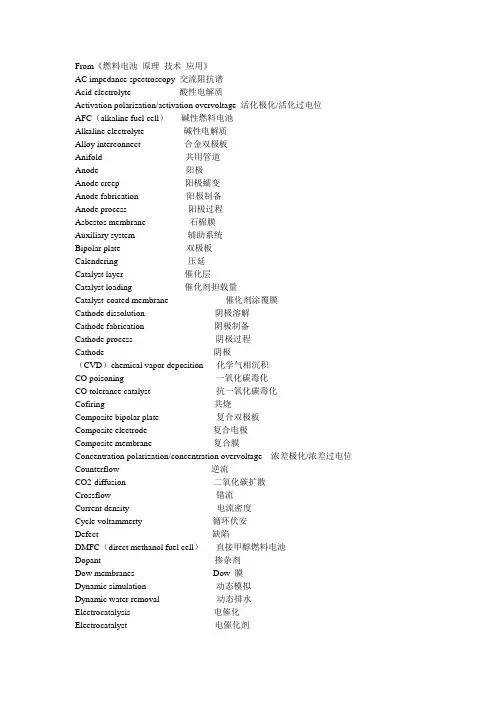
From《燃料电池原理技术应用》AC impedance spectroscopy 交流阻抗谱Acid electrolyte 酸性电解质Activation polarization/activation overvoltage 活化极化/活化过电位AFC(alkaline fuel cell)碱性燃料电池Alkaline electrolyte 碱性电解质Alloy interconnect 合金双极板Anifold 共用管道Anode 阳极Anode creep 阳极蠕变Anode fabrication 阳极制备Anode process 阳极过程Asbestos membrane 石棉膜Auxiliary system 辅助系统Bipolar plate 双极板Calendering 压延Catalyst layer 催化层Catalyst loading 催化剂担载量Catalyst-coated membrane 催化剂涂覆膜Cathode dissolution 阴极溶解Cathode fabrication 阴极制备Cathode process 阴极过程Cathode 阴极(CVD)chemical vapor deposition 化学气相沉积CO poisoning 一氧化碳毒化CO tolerance catalyst 抗一氧化碳毒化Cofiring 共烧Composite bipolar plate 复合双极板Composite electrode 复合电极Composite membrane 复合膜Concentration polarization/concentration overvoltage 浓差极化/浓差过电位Counterflow 逆流CO2-diffusion 二氧化碳扩散Crossflow 错流Current density 电流密度Cycle voltammerty 循环伏安Defect 缺陷DMFC(direct methanol fuel cell)直接甲醇燃料电池Dopant 掺杂剂Dow membranes Dow 膜Dynamic simulation 动态模拟Dynamic water removal 动态排水Electrocatalysis 电催化Electrocatalyst 电催化剂Electrochemical oxidation 电化学氧化Electrochemical reduction 电化学还原(EVD)electrochemical vapor deposition 电化学气相沉积Electrode 电极Electrolytes-membrane 电解质膜Electronic conductivity 电子电导率Electrosmotic drag coefficient 电拖动系数Empirical equation 经验方程(EW)equivalent weight 当量重量Exchange current density 交换电流密度External manifold 外公用管道Faradaic efficiency 法拉第效率Faraday law 法拉第定律FCV(fuel cell vehicles)燃料电池电气车Firing shrinkage 烧结收缩率Flat-plate design 平板型Flooding/flooded 水淹Flow distribution 流场分布Flow field 流场Fluoride sulphonate membrane 全氟磺酸膜Fluoride-type oxide 萤石型氧化物Fuel cell efficiency 燃料电池效率Fuel cell engine 燃料电池发动机Fuel cell system 燃料电池系统Fuel cell 燃料电池Fuel/air utilization 燃料空气利用率Gas diffusion electrode 气体扩散电极Gas diffusion layer 气体扩散层Heat management 热管理HHV(higherheating value)高热值Humidifier 增湿器Hydrophilic electrode 亲水电极Hydrophobic electrode 憎水电极Interdigitated flow field plate 指数流场Interlayer 夹层(中间层)Internal manifold 内公用管道Ionic conductivity 离子电导率LHV(low heating value)低热值Liquid feed 液相进料Lithium aluminate matrix 偏铝酸锂隔膜Matrix sintering 隔膜烧结Matrix 隔膜MCFC(molten carbonate fuel cell)熔融碳酸盐燃料电池MEA(membrane-electrode-assembly)膜电极“三合一”组件Membrane degradation 膜降解Mesh type flow field plate 网状流场Metal bipolar plate or metallic interconnect (SOFC)金属双极板Methanol anode polarization 甲烷阳极极化Methanol crossover 或methanol permeation 甲醇渗透Methanol diffusion 甲醇扩散Methanol tolerant electro-catalyst 抗甲醇电催化剂Micro fuel cell 微型燃料电池Mixed potention 混合电位Module 电池堆或电池模块Molding bipolar plate 模铸双极板Molten carbonate 熔融碳酸盐Nafion membrane Nafion膜Nickel sintering (coursing)镍烧结(粗化)Noble metal loading 贵金属担载量Nonfluorinated-membrane 非氟膜Nonstoichiometric defect 非化学计量缺陷Ohmic loss 欧姆损失Ohmic polarization ohmic resistance 欧姆极化欧姆电阻Open circuit voltage 开路电压Oxygen dificiency 氧缺陷Oxygen-ion transference number 氧离子迁移数PAFC(phosphoric acid fuel cell)磷酸燃料电池PEMFC(proton exchange membrane fuel cell)质子交换膜燃料电池Perovskite-type oxide 钙钛矿型氧化物Phase transformation 相转变Pin type flow field plate 针型场板Porosity 孔隙率Porous flow field plate with grooves 带沟槽的多孔材料流场板Powder synthesis 粉体合成Pyrex glass 派热克斯玻璃Reaction stoichiometric factor 反应计量因子Reformate 重整气Reformer 重整器RFC(regeneration fuel cell)再生燃料电池Screen printing 丝网印刷Self-humidification 自增湿Serpentine type flow field plate 蛇型流场Single cell 单电池Sinterability 烧结性能SOFC(solid oxide fuel cell)固体氧化物燃料电池Specific energy density 比能量密度Specific power density 比功率密度Mass activity 比质量活性Stack 电池组Static simulation 静态模拟Static water removal 静态排水Steam reforming 蒸汽重整Swell graphite bipolar plate 膨胀石墨双极板Lape casting 带铸法Thermal expansion 热膨胀Thermodynamics efficiency 热力学效率Three phase interface 三相界面Two-phase flow 两相流Vapor feed 气相进料Voltage efficiency 电压效率Water management 水管理Wet seal 湿封装YSZ Y2O3 stabilized ZrO2 三氧化二钇稳定的氧化锆。
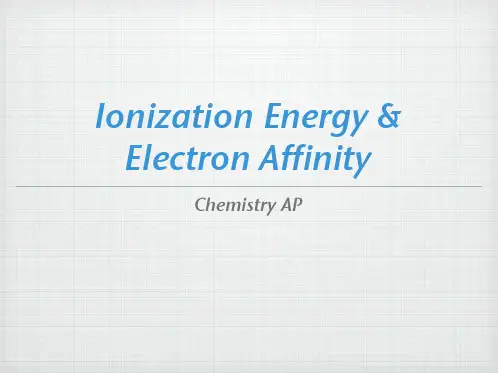
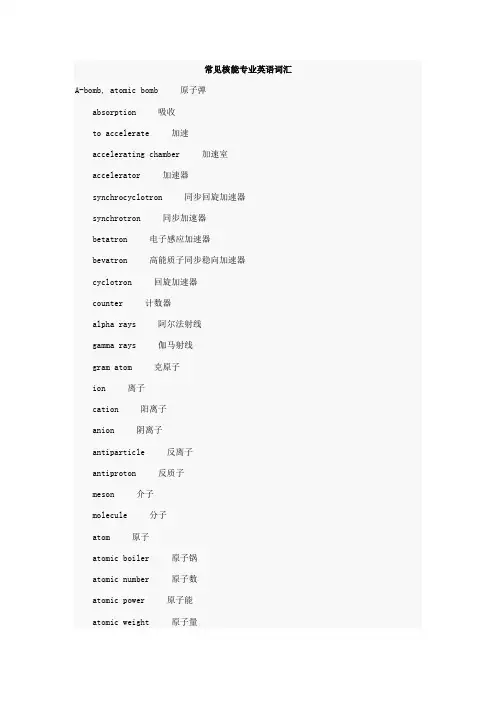
常见核能专业英语词汇A-bomb, atomic bomb 原子弹 absorption 吸收 to accelerate 加速 accelerating chamber 加速室 accelerator 加速器 synchrocyclotron 同步回旋加速器 synchrotron 同步加速器 betatron 电子感应加速器 bevatron 高能质子同步稳向加速器 cyclotron 回旋加速器 counter 计数器 alpha rays 阿尔法射线 gamma rays 伽马射线 gram atom 克原子 ion 离子 cation 阳离子 anion 阴离子 antiparticle 反离子 antiproton 反质子 meson 介子 molecule 分子 atom 原子 atomic boiler 原子锅 atomic number 原子数 atomic power 原子能 atomic weight 原子量 photon 光子 nucleon 核子 proton 质子 neutron 中子 electron 电子 free electron 自由电子 electron beam 电子束 electron cloud 电子云 electron gun 电子枪 electronic shell 电子层 electron volt 电子伏特 electrode 电极 attraction 引力 element 元素 barium 钡 berkelium 锫 beryllium 铍 cobalt 钴 uranium 铀 thorium 钍 cadmium 镉 caesium, cesium 铯 curium 锔 radium 镭 lithium 锂 neptunium 镎 boron 硼 xenon 氙 deuterium 氘 krypton 氪 deuteron 氘核 helium 氦 radon 镭射气,氡 graphite 石墨 heavy water 重水 binding energy 结合能 blast wave 冲击波 bombardment 轰击 breeder reactor 增值反应堆 bubble chamber 气泡室 burst 爆炸,爆发 capture 俘获 chain reaction 链式反应 charge 装燃料 cladding 覆层 antimatter 反物质 clean bomb 干净核弹 to collide, collision 碰撞 contamination 沾染,污染 coolant 冷却剂 cooling 冷却 cooling fluid 冷却液 cooling pond 凉水池 core 反应堆心,反应堆活性区 cosmic rays 宇宙线 critical mass 临界物质 curie 居里 to decay 衰减 decontamination 去污 diffusion 漫射 disintegration 衰变,蜕变 dispersion 弥散 emission 发射 enriched uranium 浓缩铀 enrichment 浓缩 explosion 爆炸,爆裂 fertile element 可转换元素 fission 裂变 fissionable material 裂变物质 fusion 聚变 deflagration 爆燃过程 detector 探测器 half-life 半衰期 H-bomb, hydrogen bomb 氢弹 heat exchanger 热交换器 heterogeneous reactor 非均匀反应堆 homogeneous reactor 均匀反应堆 instability 不稳定性 ionization 电离作用 irradiation 照射,辐射 isomer 同质异能素 isotope 同位素 kiloton 千吨当量 labelled molecule, tagged molecule 标记分子 leakage 泄漏 lifetime 寿命 mass 质量 megaton 百万吨级 moderator 减速剂 mushroom cloud 蘑菇云 neutron flux 中子通量 nucleus 核 nuclear tests 核实验 nuclear physics 核物理 nuclear power plant, nuclear power station 核电站 nuclear reactor 核反应堆 orbital electron, planetary electron 轨道电子 power reactor 动力反应堆 projectile 抛射体 quantum number 量子数 radiant energy 辐射能 radiation 辐射 radioactive cloud 放射云 radioactive elements 放射性元素 radioactive fallout 放射性尘降物 radioactivity 放射性 radioisotope 放射性同位素 radiology 放射学 radiotherapy 放射疗法 rod 棒 roentgen 伦琴 scattering 散射 separation 分离 shield 防护罩 shock wave 冲击波 spectrometer 分光计 spin 反旋 to split 分裂 stability 稳定,对衰变的抗性 thermal neutron 热中子 thermal reactor 热反应堆 thermionic 热电子的 thermonuclear 热核的 tracer element 示踪原子 trajectory 轨迹 trinitrotoluene 三硝基甲苯,黄色炸药 underwater test 水下试验 warhead 弹头。
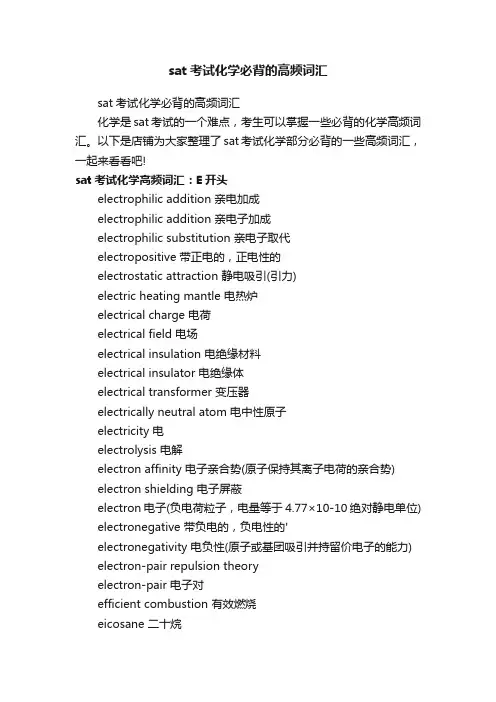
sat考试化学必背的高频词汇sat考试化学必背的高频词汇化学是sat考试的一个难点,考生可以掌握一些必背的化学高频词汇。
以下是店铺为大家整理了sat考试化学部分必背的一些高频词汇,一起来看看吧!sat考试化学高频词汇:E开头electrophilic addition 亲电加成electrophilic addition 亲电子加成electrophilic substitution 亲电子取代electropositive 带正电的,正电性的electrostatic attraction 静电吸引(引力)electric heating mantle 电热炉electrical charge 电荷electrical field 电场electrical insulation 电绝缘材料electrical insulator 电绝缘体electrical transformer 变压器electrically neutral atom 电中性原子electricity 电electrolysis 电解electron affinity 电子亲合势(原子保持其离子电荷的亲合势)electron shielding 电子屏蔽electron 电子(负电荷粒子,电量等于4.77×10-10绝对静电单位) electronegative 带负电的,负电性的'electronegativity 电负性(原子或基团吸引并持留价电子的能力) electron-pair repulsion theoryelectron-pair 电子对efficient combustion 有效燃烧eicosane 二十烷electric current 电流sat考试化学高频词汇:L开头low pressure 低压low-density poly(ethene) 低密度聚乙烯low-energy collisions 低能量碰撞LP-LP repulsion> LP-BP repulsion> BP-BP repulsion Lubricant 滑润剂lubricant 润滑剂lubricating oil 润滑油lepton 轻粒子lime water 石灰(水溶液)lime 石灰limelight 灰光灯limestone 石灰石liquid circulates 液体循环liquid phase 液相liquid state 液态liquid 液体sat考试化学高频词汇:M开头metallic element 金属元素metallic radius 金属半径meteorite 陨星methane 甲烷methanol (=CH3OH) 甲醇methoxymethane 甲氧基甲烷methyl(-CH3) 甲基Methylpropane 甲基丙烷microbe 微生物,细菌Millikan’s ‘oil-drop’ ecperiment 密立根油滴实验mineral 矿物质miscibility with water 与水的互溶性magnetise 磁化malleable 有延展性的Maltese Cross 马耳他十字marble 大理石marine invertebrate 海里的无脊椎动物mass number 质量数mass spectrometer 质谱仪matter 物质mechanism 机理megawatt 兆瓦,即106瓦。
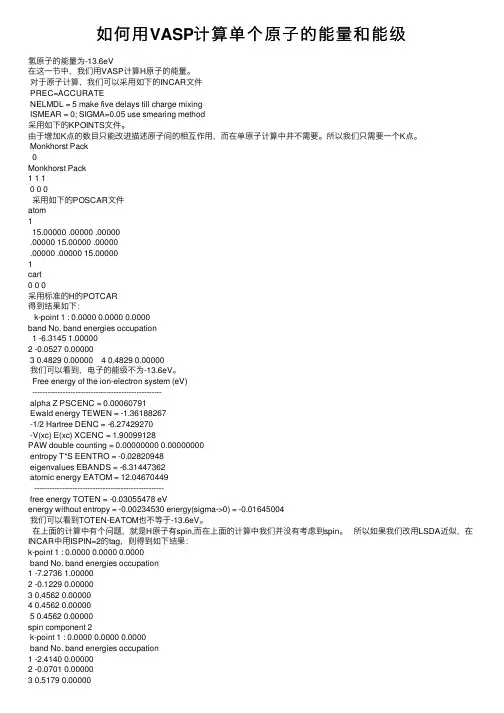
如何⽤VASP计算单个原⼦的能量和能级氢原⼦的能量为-13.6eV在这⼀节中,我们⽤VASP计算H原⼦的能量。
对于原⼦计算,我们可以采⽤如下的INCAR⽂件PREC=ACCURATENELMDL = 5 make five delays till charge mixingISMEAR = 0; SIGMA=0.05 use smearing method采⽤如下的KPOINTS⽂件。
由于增加K点的数⽬只能改进描述原⼦间的相互作⽤,⽽在单原⼦计算中并不需要。
所以我们只需要⼀个K点。
Monkhorst PackMonkhorst Pack1 1 10 0 0采⽤如下的POSCAR⽂件atom115.00000 .00000 .00000.00000 15.00000 .00000.00000 .00000 15.000001cart0 0 0采⽤标准的H的POTCAR得到结果如下:k-point 1 : 0.0000 0.0000 0.0000band No. band energies occupation1 -6.3145 1.000002 -0.0527 0.000003 0.4829 0.000004 0.4829 0.00000我们可以看到,电⼦的能级不为-13.6eV。
Free energy of the ion-electron system (eV)---------------------------------------------------alpha Z PSCENC = 0.00060791Ewald energy TEWEN = -1.36188267-1/2 Hartree DENC = -6.27429270-V(xc) E(xc) XCENC = 1.90099128PAW double counting = 0.00000000 0.00000000entropy T*S EENTRO = -0.02820948eigenvalues EBANDS = -6.31447362atomic energy EATOM = 12.04670449---------------------------------------------------free energy TOTEN = -0.03055478 eVenergy without entropy = -0.00234530 energy(sigma->0) = -0.01645004我们可以看到TOTEN-EATOM也不等于-13.6eV。
宝石能谱CT在诊断胰腺黏液性囊性肿瘤与浆液性囊腺瘤中的应用价值陈湘光;杨志企;黄送【摘要】探讨宝石能谱CT在鉴别诊断黏液性囊性肿瘤(mucinous cystic neoplasm,MCN)与浆液性囊腺瘤(serous cystadenoma,SCA)中的应用价值.方法回顾性分析2014年7月-2015年7月经手术病理证实的32例胰腺囊腺肿瘤临床资料,均给予宝石能谱CT检查,比较MCN与SCA的临床特征、不同能量水平CT 值、不同扫描期下配对基物质浓度、宝石能谱CT检测与术后病理符合率.结果临床特征:MCN年龄、病灶直径、有症状例数明显高于SCA(t =6.472~8.284,P<0.05);不同能量水平CT值:MCN动脉期40 keV、50 keV、60 keV、70 keV时,门静脉期40 keV、50 keV、60 keV时,CT值均明显高于SCA(t =2.093~6.785,P <0.05);配对基物质浓度:MCN动脉期钙(水)、水(钙)、碘(水)、水(碘)浓度均明显高于SCA,门静脉期钙(水)、碘(水)浓度均明显高于SCA(t=2.071 ~7.124,P<0.05);术后病理检测符合率:宝石能谱CT检出黏液性12例,检出浆液性20例,与术后病理检出相符30例,符合率93.75%(30/32).结论胰腺MCN与SCA宝石能谱CT有明显的不同特征,通过对不同能量CT值、不同期相配对基物质浓度的比较,结合临床特征,有助于提高MCN与SCA诊断准确率.【期刊名称】《胃肠病学和肝病学杂志》【年(卷),期】2016(025)006【总页数】4页(P698-701)【关键词】宝石能谱CT;胰腺囊性肿瘤;CT值;配对基物质浓度【作者】陈湘光;杨志企;黄送【作者单位】梅州市人民医院CT科,广东梅州514031;梅州市人民医院CT科,广东梅州514031;梅州市人民医院CT科,广东梅州514031【正文语种】中文【中图分类】R735.9胰腺囊性肿瘤是一组相对少见的疾病,约占全部胰腺肿瘤的1%~2%[1],主要病变形式包括黏液性囊性肿瘤(mucinous cystic neoplasm,MCN)、浆液性囊腺瘤(serous cystadenoma,SCA)、导管内乳头状黏液性肿瘤(intraductal papillary mucinous neoplasm,IPMN)、实性假乳头状瘤(solid pseudopaillary tumor of the pancreas,SPTP)等,其中MCN、SCA较多见,由于胰腺囊腺瘤所处位置较深,生长缓解,且两者生物学行为不同,术前明确病变性质对制定治疗方案与手术方式具有指导意义[2]。
A1、absorptions coefficient——吸收系数, 吸收强度(α-吸收系数)2、aperture diameter width——开口直径,指槽式聚光镜抛物槽的开口直径大小3、axis——轴4、azimuth——方位角,方位角又称地平经度(Azimuth (angle)缩写Az),是在平面上量度物体之间的角度差的方法之一。
是从某点的指北方向线起,依顺时针方向到目标方向线之间的水平夹角。
5、absorptance——吸收率6、assembly——组装7、Alternating current——交流电8、AM, air mass的缩写, 空气质量.直射阳光光束透过大气层所通过的路程,以直射太阳光束从天顶到达海平面所通过的路程的倍数来表示。
9、Anneal——退火10、as-built drawing——竣工图B1、bypass valve——旁路阀2、biomass——生物质,太阳能电站混合供电系统中用到的生物质发电技术C1、concentrating Solar Power——聚光式太阳能发电,简称CSP,又叫做STP(Solar Thermal Power)——光热太阳能发电2、concentrator——聚光器或聚光镜3、collector——集热器,直接将太阳能转化为热能,使用高储热的物质诸如水或油等,之后使用热交换器使用所搜集的热量。
是聚光太阳能设备的总称,其中包括,concentrator(聚光镜)和receiver(接收器).4、collecting loop 集热回路,槽式太阳能集热回路包括两种模式,一种是双回路系统,包括导热油(HTF系统)和(水蒸汽系统),另一种叫DSG系统,直接产生蒸汽系统。
两种系统的区别在于,第一种是由导热油做为热量转换的中间介质,而后者是太阳能直接转化为水蒸气的热能。
第一种系统效率低于第二种,第二种技术对集热管要求较高。
(Skyfuel公司在文件中介绍的便是采用南北向布置的双回路带储能的槽式发电系统。
A1、absorptions coefficient——吸收系数, 吸收强度(α-吸收系数)2、aperture diameter width——开口直径,指槽式聚光镜抛物槽的开口直径大小3、axis——轴4、azimuth——方位角,方位角又称地平经度(Azimuth (angle)缩写Az),是在平面上量度物体之间的角度差的方法之一。
是从某点的指北方向线起,依顺时针方向到目标方向线之间的水平夹角。
5、absorptance——吸收率6、assembly——组装7、Alternating current——交流电8、AM, air mass的缩写, 空气质量.直射阳光光束透过大气层所通过的路程,以直射太阳光束从天顶到达海平面所通过的路程的倍数来表示。
9、Anneal——退火10、as-built drawing——竣工图B1、bypass valve——旁路阀2、biomass——生物质,太阳能电站混合供电系统中用到的生物质发电技术C1、concentrating Solar Power——聚光式太阳能发电,简称CSP,又叫做STP(Solar Thermal Power)——光热太阳能发电2、concentrator——聚光器或聚光镜3、collector——集热器,直接将太阳能转化为热能,使用高储热的物质诸如水或油等,之后使用热交换器使用所搜集的热量。
是聚光太阳能设备的总称,其中包括,concentrator(聚光镜)和receiver(接收器).4、collecting loop 集热回路,槽式太阳能集热回路包括两种模式,一种是双回路系统,包括导热油(HTF系统)和(水蒸汽系统),另一种叫DSG系统,直接产生蒸汽系统。
两种系统的区别在于,第一种是由导热油做为热量转换的中间介质,而后者是太阳能直接转化为水蒸气的热能。
第一种系统效率低于第二种,第二种技术对集热管要求较高。
(Skyfuel公司在文件中介绍的便是采用南北向布置的双回路带储能的槽式发电系统。
中煤鄂尔多斯能源化工有限公司30万t/a聚丙烯装置采用Unipol 气相流化床工艺,该工艺采用特有的流化床反应器和先进的催化剂技术,该工艺设计简单、产品质量稳定均一、能效高[1]。
此次生产应用研究公司使用进口SHAC201催化剂及给电子体ADT5100生产开发新产品牌号L5D98。
L5D98牌号产品为双向拉伸聚丙烯(BOPP)薄膜,BOPP薄膜无色、无味、无毒,具有良好的拉伸性能、冲击性能、透明性和光泽度,是一种理想的包装材料[2-6]。
针对L5D98膜料生产过程开展应用研究,比较并分析主要指标的影响因素,总结操作经验,为同类工艺聚丙烯装置的工艺参数调控提供借鉴。
1 试验部分1.1 主要试剂及原料丙烯:纯度不小于99.5%,中煤鄂尔多斯能源化工有限公司;H2:纯度不小于99.9%,中煤鄂尔多斯能源化工有限公司:SHAC201催化剂及给电子体ADT5100\ADT5500:美国GRACE公司;三乙基铝:诺力昂化学品(嘉兴)有限公司。
1.2 试验方法1.2.1 试验准备装置生产L5E89稳定运行,产品质量合格,各关键设备、仪表运行平稳;干净的给电子体备用罐加入给电子体ADT5100;添加剂秤内加入L5D98添加剂,下料比例设定2.05kg/t。
1.2.2 试验过程将反应器H2/C3控制在0.003mol%,粒料熔融指数控制在3.0g/10min;将给ADT5500系统切换至ADT5100,将Al/Si摩尔比由5.2降到4,维持反应器床重、压力、温度稳定,当等规度达到98以下,挤压造粒机组更换L5D98添加剂,切换料仓至L5D98料仓。
1.3.3 生产牌号由拉丝L5E98切换至薄膜L5D98,主要参数对比见表1。
表1 工艺参数表主要参数单位L5E89L5D98主催化剂型号—SHAC™ 201SHAC™ 201 1#反应器SCA型号—ADT5500ADT51001#反应器熔融指数 g/10min 3.33等规指数%98±296±2二甲苯%2~44~6催化剂载体流量(丙烯)kg/h130~140130~140 1#反应器温度℃69.569.51#C3分压MPa 2.6~2.8 2.6~2.8 1#反应器TEAL/Ti mol/mol45~5045~501#反应器TEAl/SI mol/mol5~5.5 3.8~4.31#反应器H2/C3mol/mol0.0048~0.00510.0025~0.00351#反应器床重t40~4240~421#反应器床高m17.5~18.517.5~18.51#反应器表观气速m/s0.35~0.370.35~0.37Unipol聚丙烯工艺L5D98膜料生产应用研究马帅中煤鄂尔多斯能源化工有限公司 内蒙古 鄂尔多斯 017000 摘要:主要介绍了Unipol气相流化床聚丙烯的工艺L5D98膜料生产应用情况。
太阳光伏能源系统术语一、一般术语1、太阳光伏能源系统—solar photovoltaic energy system指利用太阳能电池的光生伏特效应,将太阳辐射能直接转换成电能的发电系统。
2、太阳电池—solar cell指太阳辐射能直接转换成电能的一种器件。
3、硅太阳电池—silicon solar cell指以硅为基体材料的太阳电池。
4、单晶硅太阳电池—single crystalline silicon solar cell指以单晶硅为基体材料的太阳电池。
5、非晶硅太阳电池(a-Si太阳电池)—amorphous silicon solar cell指用非晶硅材料及其合金制造的太阳电池。
亦称无定形硅太阳电池,简称a-Si太阳电池。
6、PIN(NIP)非晶硅太阳电池—PIN(NIP)a-Si solar cell指由P(N)型非晶硅,本征非晶硅和N(P)型非晶硅构成的太阳电池。
其光照面为P (N)型区。
7、集成型非晶硅太阳电池—integrated a-Si solar cell指用激光切割或其他方法把生长在同一块玻璃衬底或其它衬底上的非晶硅太阳电池切割成许多单体,使其串联、并联而构成的电池。
8、多晶硅太阳电池—polycrystalline silicon solar cell指以多晶硅为基体材料而制作的太阳电池。
9、多晶太阳电池—polycrystalline solar cell指用多晶材料为基体而制作的太阳电池。
10、多结太阳电池—multi-junctions solar cell指由多个p-n结形成的太阳电池。
这类电池的光电转换效率较高。
光谱响应有所改善。
11、垂直多结太阳电池—vertical multi-junction solar cell指与常规不同的一种太阳电池,其光照表面层被腐蚀成许多相互平行,有一定间距和深度的槽,用适当工艺在槽壁、槽底和槽顶部制成一个连续的p-n结,结的大部分或全部与光照面垂直。
Energy-Dependent Electron-Electron Scattering and Spin Dynamics in a Two Dimensional Electron Gas. W.J.H.Leyland a,b, R.T.Harley a, M.Henini c, A.J.Shields d, I.Farrer b and D.A.Ritchie ba School of Physics and Astronomy, University of Southampton SO17 1BJ, UKb Cavendish Laboratory,University of Cambridge, Madingley Road, Cambridge CB30HE , UKc School of Physics and Astronomy, University of Nottingham NG7 4RD, UKd Toshiba Research Europe Ltd, Cambridge CB4 4WE, UKAbstractMeasurements of spin dynamics of electrons in a degenerate two dimensional electron gas, where the Dyakonov-Perel mechanism is dominant, have been used to investigate the electron scattering time (τp*) as a function of energy near the Fermi energy. Close to the Fermi energy the spin evolution is oscillatory, indicating a quasi-collision-free regime of spin dynamics. As the energy is increased a transition to exponential, collision-dominated, spin decay occurs. The frequency and the value of τp* are extracted using a Monte Carlo simulation method. At the Fermi energy τp* is very close to the ensemble momentum relaxation time (τp) obtained from the electron mobility. For higher energies τp* falls quadratically, consistent with theoretical expectations for the onset of electron-electron scattering which is inhibited by the Pauli principle at the Fermi energy.PACS: 73.21.Fg, 72.25.Rb, 71.70.EjIntroductionInvestigation of the electron spin dynamics in semiconductors can reveal detail of both the spin-orbit interaction and of electron scattering mechanisms. Here we exploit this to study experimentally the energy dependence of electron-electron scattering near the Fermi level of a two-dimensional electron gas.This is possible because in III-V semiconductors and especially in quantum wells the Dyakonov-Perel mechanism [1,2] is usually the most important for relaxation of a non-equilibrium electron spin population. In this case reorientation of the spins is caused by spin-orbit interaction which can be represented as an effective, momentum-dependent magnetic field or precession vector Ωk acting on an electron’s spin. Scattering which randomises the momentum of an electron thus randomises the precession and if the scattering rate (1/τp *) exceeds the precession frequency, as is normal, the spin evolution is an exponential relaxation. In this way scattering which does not result directly in spin-flips produces spin relaxation. The spin relaxation rate along an axis i is [1,3]*/12,p i s ττ>Ω=<⊥ (1)where <Ω⊥2> is the average square of the component of the precession vector in the plane perpendicular to i .In the (less usual) case of weak momentum scattering an electron spin may precess through several complete cycles before undergoing momentum scattering[4,5]. The approach to equilibrium of the spin population may then be oscillatory provided its precession frequency is sufficiently homogeneous, for example if the spin polarized electrons are all close to the Fermi momentum in a two dimensional electron gas (2DEG) [5,6].In recent papers [5,6,7] we have described optical investigations of electron spin dynamics near the Fermi energy (E F ) in a series of high mobility 2DEGs confined in GaAs/AlGaAs quantum wells at temperatures from 1.5K to 300K. This demonstrated the transition from the weak scattering regime at low temperatures to the strong scattering regime at high temperatures. At low temperatures we have observed oscillatory spin dynamics allowing separate determination of the momentum scattering rate and the spin-orbit interaction as a function of quantum well width [5,7]. The scattering rate (1/τp *) was found to be close to the ensemble momentum relaxation rate (1/τp ) given by measurement of the mobility. At high temperatures we observed exponential spin relaxation with a rate which fell rapidly to a minimum value in the region of the Fermi temperature (E F /k B ) [6]. We showed that this behaviour, a clear example of the motional narrowing (or slowing) characteristic of the Dyakonov-Perel mechanism [1] (see eq. 1), is caused by the onset of strong electron-electron scattering as the 2DEG moves away from full degeneracy [8]. We found that, in general, the total scattering rate is given byee p p τττ/1/1*/1+= (2)where 1/τee is the electron-electron scattering rate.In this paper we describe spin-dynamic measurements of the energy dependence of the scattering. By working at low temperatures we separate the precession and scattering components of the spin dynamics and we vary the electronenergy with respect to the Fermi energy at fixed values of temperature by varying thephoton energy which is used to inject the spin-polarised electrons into the 2DEG. The scattering rate 1/τp* increases rapidly with energy in reasonable agreement with the theoretical expectation that the contribution from 1/τee vanishes for electrons at the Fermi surface due to the Pauli principle and increases approximately quadraticallywith increase of energy [9,10,11]. Our results are comparable with those obtained from four-wave-mixing measurements by Kim et al. [12].2) Experimental details.The sample used for these measurements was a (001)-oriented one-side n-modulation doped single GaAs/Al0.35Ga0.65As quantum well with nominal width 20 nm. It is one of the series used in our previous studies [5,6,7], T539, and was chosen because it has the highest electron mobility at 5 K corresponding to ensemble momentum relaxation time τp = 27 ps [6]. The electron confinement energy E1e = 10.2 meV and Fermi energy E F = 6.2 meV were determined using photoluminescence (PL) and photoluminescence excitation (PLE) spectroscopy [6]. The spin-dynamics of the 2DEG was investigated using the picosecond-resolution pump-probe optical reflection technique we have described earlier [13]. The circularly-polarized pump beam intensity was typically 0.5 mW focused to a 60 micron diameter spot giving an estimated photoexcited spin-polarized electron density 5x109 cm-2, very much less than the unpolarised electron concentration in the 2DEG; the probe power density was 25% of the pump. The pump and probe photon energies were degenerate and could be tuned to energies spanning the Fermi energy of the 2DEG. The technique measures both the time-evolution of the probe polarization rotation, ∆θ, which is proportional to the component of electron spin-polarisation along the growth axis, <S z>(t), and also the change of reflected intensity ∆R, which gives the photo-excited population. Over the timescale of the decay of ∆θ we found that ∆R was essentially constant so that the observed evolution of ∆θ, and therefore of <S z>(t), is not significantly affected by recombination of the spin-polarised electrons. The spectral resolution of these measurements is set by the pulse duration of pump and probe pulses and is ~ 0.8 meV. For measurements at 5 K the sample was mounted in a liquid helium flow cryostat surrounded by cold gas whereas for 1.5 K measurements it was immersed in superfluid helium.Thermal rounding of the Fermi surface is ~ 0.5 meV at 5 K and ~ 0.15 meV at 1.5 K.3) Results.Fig. 1 shows examples of ∆θ (ie <S z>(t)) signals at 1.5 K and at 5 K measured at several different values of excitation energy expressed in the form E/E F where E is measured from the bottom of the n=1 conduction sub-band. The photon energy required to excite an electron to the Fermi level of the 2DEG was taken to be the half-intensity point of the onset of PLE, 1.5241 eV at 5 K (see Fig. 3b) and the zero of the energy scale is taken 6.2 meV lower, 1.5179 eV. At 1.5 K the spin evolution was a damped oscillation for all energies investigated, as indicated for example by the upper trace in Fig. 1, whereas at 5 K the evolution was found to change progressively from oscillatory to monotonic and eventually exponential as the energy was increased (see lower traces of Fig. 1).It can be seen in Fig.1 that the sign of the signal inverts just above E F. This is a feature of the nonlinear reflectivity technique which we have found in all the samples we have investigated and is discussed more fully in a previous paper [7]. Although the magnitude and sign of the signals are functions of energy, the extractedvalues of precession frequency and scattering rate are unaffected by the phase inversion. Maximum signal strength was observed adjacent to the phase inversion, on each side, falling to the noise level ~ 5 meV above the Fermi energy.Fig. 2 shows results of a Monte Carlo simulation of the data for a precession frequency Ωex= 0.063 radians/ps and a range of values of τp*. The calculations were performed for a population of 104 electrons injected at time zero with spins oriented along the growth axis and momenta distributed at random on the Fermi surface. Evolution of the z-component of the total spin of this ensemble was calculated in time steps δt = 1 ps. During each step each electron spin was subject to a precession vector determined by its wavevector, assuming the Dresselhaus form of spin-splitting. At the end of each step it was subject to a possibility of elastic scattering δt/τp* to a new randomly chosen wavevector giving a new precession vector. The simulation reproduces the experimental behaviour very well and enables extraction of reliable values of precession frequency and the momentum scattering time τp*. We have described our procedure for this in previous papers [5,7]. In the simulations the boundary between oscillatory and monotonic spin evolution occurs at Ωexτp* = ½.The extracted precession frequency was found to be constant within experimental uncertainties at 0.063±0.006 radians/ps over the energy and temperature range investigated whereas the scattering time which is closely correlated with the damping of the observed signal varied strongly. Fig.3a shows the values of τp* as a function of electron energy; there is a plateau in the vicinity of the Fermi energy and a very rapid fall with increasing energy. The solid points indicate oscillatory spin evolution whereas monotonic decay is indicated by open symbols.4) Discussion and conclusionsFirst consider the observed transition from oscillatory to monotonic spin dynamics as indicated by the solid and open symbols in Fig. 3a. The boundary separating shaded and unshaded regions in Fig. 3a is a plot of 1/(2Ωex) where Ωex is the calculated value of precession frequency at the excitation energy taking the value at the Fermi energy to be ΩF = 0.063 radians/ps and assuming Ωex ~ E1/2. The curve corresponds to the condition Ωexτp* = ½, indicated by the Monte Carlo simulations to be the boundary between oscillatory and monotonic spin evolution. As expected it nicely separates the regions where oscillatory and monotonic spin evolution are observed experimentally.Now consider the observed energy and temperature dependence of the electron momentum scattering time τp* (Fig.3a). Since the contribution from the ensemble momentum relaxation rate 1/τp, as indicated by the measured mobility, is essentially constant in this region, the variation must be due primarily to the electron-electron scattering rate 1/τee.The latter has been considered theoretically by several authors. Analytic expressions for the temperature dependence of the scattering rate at energy E F and for the energy dependence at T = 0 were derived in refs. 9 and 10. Comparing these formulae with numerical calculations of the combined effect of energy and temperature variation, Jungwirth and MacDonald [11] have concluded that for T/T F≤0.1 and energies ζ≡(E-E F)/E F≤ 0.1 a sum of the analytic expressions is a very good approximation. For our sample T F = 72K so these condition hold and we expect),0(/1)0,(/1),(/1T T ee ee ee τζτζτ+=∗ (3)where(4)and⎥⎥⎦⎤⎢⎢⎣⎡⎟⎟⎠⎞⎜⎜⎝⎛−⎟⎟⎠⎞⎜⎜⎝⎛=F B F B F ee E T k E T k E A T ln 96.02.),0(/122πτ (5)A is a constant which specifies the electron-electron scattering strength. The dotted and solid curves in Fig. 3a are calculated values of τp * at T =1.5K and at 5K respectively obtained using eqs. 3, 4 and 5 and with τp set at the value 27 ps indicated by our mobility measurements. The value of A was chosen to be 0.4 to give a fit to the data. This value of the scattering strength is consistent with that used in our analysis of the full temperature dependence of the spin relaxation time described in our previous paper [6]. The agreement between the calculation and experiment is reasonably good indicating the correctness of the approach.In conclusion, we have used measurements of spin dynamics to investigate the energy and temperature dependence of electron-electron scattering in the vicinity of the Fermi energy in a quasi-degenerate two dimensional electron gas. The scattering time for electrons at the Fermi energy is close to the momentum scattering time given by a measurement of the electron mobility and decreases quadratically as the energy is increased. The form and magnitude of the decrease is consistent with additional scattering due to electron-electron interaction in accordance with theoretical expectations. The observed spin dynamics show a transition from oscillatory to exponential time evolution as the electron energy increases which is very well accounted for by a Monte Carlo simulation based on the Dyakonov-Perel mechanism of spin dynamics.References[1] M.I.D’yakonov and V.I.Perel’, Sov. Phys.–Solid State ,13 , 3023 (1971).[2] M.I.D’yakonov and V.Yu.Kachorovskii, Sov. Phys.–Semicond .,20 , 110 (1986).[3] M E Flatté, J M Byers and W H Lau Semiconductor Spintronics and QuantumComputation : chapter 4, Spin Dynamics in Semiconductors ed D D Awschalom et al (Berlin: Springer) (2002).[4] V.N. Gridnev JETP Letters, 74 380 (2001).[5] M.A.Brand, A.Malinowski, O.Z.Karimov, P.A.Marsden, R.T.Harley, A.J.Shields,D.Sanvitto, D.A.Ritchie and M.Y.Simmons, Phys. Rev. Lett. 89 236601 (2002).[6] W.J.H.Leyland, G.H.John, R.T Harley, M.M.Glazov, E.L.Ivchenko, D.A Ritchie,I. Farrer, A.J. Shields and M Henini, Phys. Rev. B75, 165309 (2007).[7] W.J.H.Leyland, R.T.Harley, M.Henini, A.J.Shields, I.Farrer, and D.A.Ritchie,Phys. Rev. B76, 195305 (2007).[]ζζζτln 54.1.)0,(/12−=F ee E A[8] M.M.Glazov and E.L.Ivchenko, JETP Lett. 75, 403 (2002); M.M.Glazov andE.L.Ivchenko, JETP99 1279 (2004).[9] G.F.Giuliani and J.J.Quinn, Phys. Rev B26 4421 (1982).[10] L.Zheng and S.Das Sarma, Phys. Rev.B53 9964 (1996).[11] T.Jungwirth and A.H.MacDonald, Phys. Rev. B53 7403 (1996).[12] Dai-Sik Kim, J.Shah, J.E.Cunningham, T.C.Damen, S.Schmitt-Rink andW.Schäfer, Phys. Rev. Lett.68 2838 (1992).[13] R.T.Harley, O.Z.Karimov, and M.Henini, J. Phys. D36, 2198 (2003).Figure 1Examples of∆θ (ie <S z >(t )) signals at 1.5K and at 5K for a range of electron energies relative to the Fermi energy. At 1.5K the observed decays were all oscillatory whereas at 5K there is a transition from oscillatory to monotonic decay as the energy increases. The sign of the signals inverts near to E F as discussed in the text.<S >(t ) (a r b . u n i t s )Probe delay (ps)Figure 2 Results of Monte Carlo simulation of Dyakonov-Perel spin decays as described in the text. The precession frequency, Ωex , was kept fixed at 0.063 ra/ps and the electron momentum scattering time τp * was varied to give different values of Ωex τp *. The transition from oscillatory to monotonic decay occurs at Ωex τp *=½.Delay (ps)Figure 3 (a) Experimental values of τp* extracted from data of figure 1 at 1.5K and 5K using the Monte Carlo simulation method described in the text and in ref 7. Solid symbols correspond to oscillatory spin decays and open symbols monotonic relaxations. Solid and dotted curves are theoretical fits as described in the text. The boundary of the shaded region corresponds to Ωex τp *½ in the simulations. (b) Photoluminescence excitation (PLE) spectrum at 5K for detection at 1.516 eV. The horizontal bar indicates the resolution set by the spectral width of the mode-locked Ti-sapphire laser. The Fermi energy E F was taken to be the half intensity point of the PLE .Photon energy (eV)。